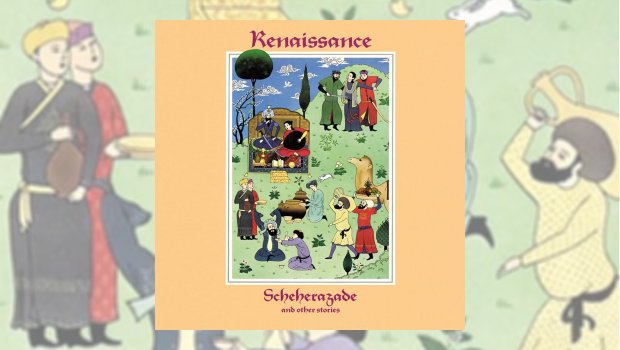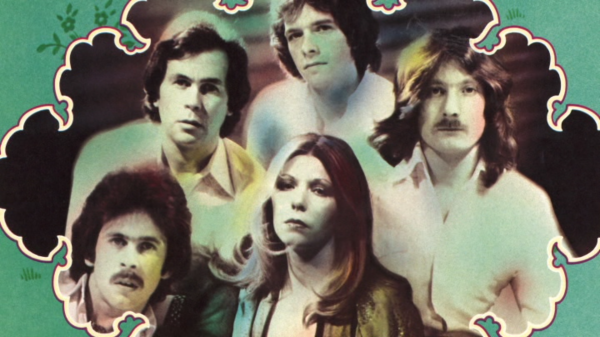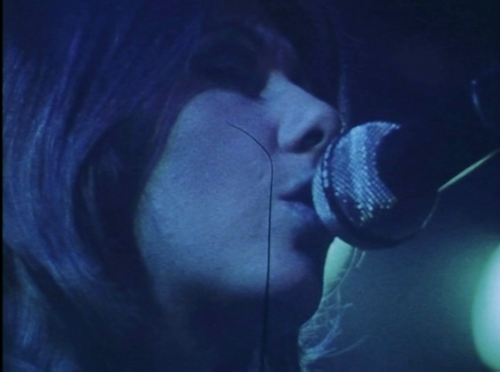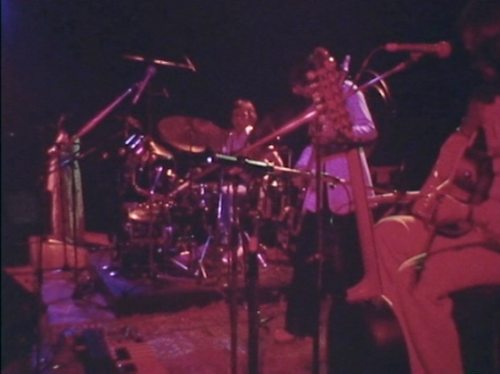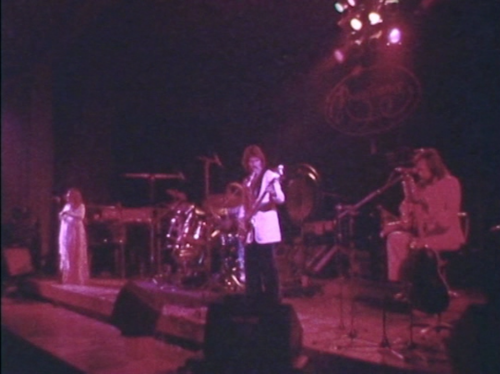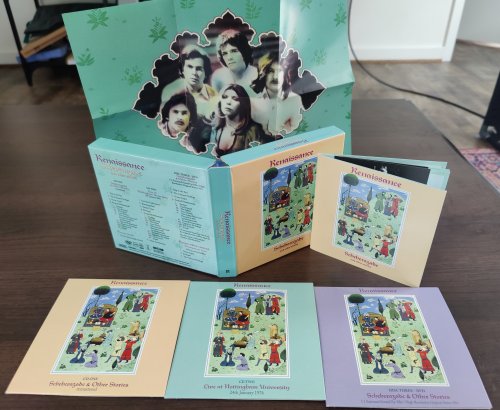Reviewing this album honestly feels like cheating. Most albums we humble scribblers have to review require us to take a leap into the unknown to something between the latest sensation and an abysmal waste of time. Scheherazade and Other Stories, on the other hand, is a bona fide classic, and undoubtedly one of the masterpieces of the classic era of progressive rock. It currently sits at #35 on ProgArchives’ Top Prog Albums list – perhaps the only reliable measure of worth available to us – above such venerated albums as Genesis’s The Lamb Lies Down on Broadway, Dream Theater’s Images and Words and Pink Floyd’s Meddle. This was quite the opposite of a leap into the unknown for me, more of a sinking back into the comfortable cushions of familiarity.
Blending rock music with an orchestra was nothing new by the time Renaissance came around; plenty of bands had given it a go, including The Beatles (A Day in the Life), The Moody Blues (Days of Future Passed), Yes (Time and a Word), Uriah Heep (Salisbury) and, of course, Deep Purple with Concerto for Group and Orchestra. But I’ve yet to hear another band so organically and harmoniously blend the two as Renaissance.
The band had begun experimenting with more ambitious arrangements on Ashes Are Burning where two of the songs featured string arrangements to great effect. Their subsequent album, Turn of the Cards, featured a full orchestra, most notably on Mother Russia, an instant fan favourite. Despite the sonic upgrade, both albums still feel like two halves of a double album, with some easy comparisons to draw between them – six songs each, begins with an exciting epic track, ends with a more melancholic epic track, etc. Renaissance would really need to break the mould to improve.
And that’s exactly what they did on Scheherazade and Other Stories. While Side 1 featured some rather pedestrian band-only tracks, Side 2 featured a miniature opera – based on the story of One Thousand and One Nights – that completely eclipsed their previous work. At 25-minutes, this elaborate piece managed to balance the timbre and melodic capabilities of the orchestra with the rhythm and power of progressive rock. Never has ‘symphonic rock’ lived up to its name more.
The first track on the album is Trip to the Fair, and if the band were trying to recreate the success of their previous two album openers – Can You Understand and Running Hard – then they unfortunately failed. At nearly 11-minutes, this track is rather long and fragmented with few moments that truly impress. On live versions that I have heard, the three-minute opening instrumental sounds a lot better, with the rhythm on the hi-hat accentuated; on the album version, however, the sound is somewhat muted and the way the piece starts and stops stunts what could have been a more exciting intro. I’ve never been fond of the chorus to this song either: “A trip to the fair / But nobody was theeeeere” becomes rather grating, especially in the outro. The only part of the song that was a joyous discovery to me on this relisten was the jazzy interlude that starts in the seventh minute.
The Vultures Fly High has always tickled me, as the lyrics are about music critics who would write terribly negative reviews; sound like anyone you know? At a mere three-minutes, this energetic track was clearly designed to condense the Renaissance sound for airplay, but the band put on a passionate performance nonetheless. However, the rather blatant lyrics do make the band seem especially bitter:
…
“They always watch with hollow eyes / To put you down / They always find a way to criticise”
…
“And though you haven’t much to give / You know they’d take it yours and mine”
Clearly we’re a bunch of predatorial so-and-so’s who take great pleasure in our condescension! Mwahahahaha!
Ocean Gypsy rounds out Side 1, and for the life of me I cannot get into this one. It’s too soft, too airy-fairy, and not nearly exciting enough to draw my interest. It honestly sounds like a song that was designed for your nan to listen to. I think one of the reasons that Renaissance doesn’t attract more fans within the prog community is because of songs like Ocean Gypsy and the misapprehension that all their songs sound like that. Certainly, the band is too ‘soft’ for some, but Ocean Gypsy really takes the biscuit.
Making up for this collection of tepid tracks is, of course, the title track Song of Scheherazade. The piece is split into nine thematically linked subsections, most of which flow into each other. In fact, there are only two times that the piece comes to a complete standstill, and it’s a point of minor irritation that the band couldn’t have found some way to stitch those pieces together.
Nevertheless, the piece works perfectly, both musically and thematically. It might have been tempting to fit as much of the story into the song’s 25-minutes as possible, but the band prudently restrict the lyrical parts to three of the nine parts, allowing the music to breathe and evoke the Arabian atmosphere.
The lyrics are fantastic, their brevity and simplicity sucking me into the story. I have a particular fondness for the line “And her beauty shone / Like a flower grown / Gentle as he’d ever known”, it always stirs emotion within me. However, when you consider the tale in question, it does seem like a song that wouldn’t get made today: a ruthless sultan who sleeps with virgin women one night and beheads them the next day meets Scheherazade, who manages to trick him into not beheading her, and they eventually fall in love and live happily ever after. The morals of this dire story are questionable indeed, and you’d hope for a world where the sultan is made to pay for his crimes and that Scheherazade doesn’t reward his actions with her love. But the music and lyrics that Renaissance found to accompany this classic tale more than make up for any moral ambiguities it might have.
Musically, the piece features a lot of contrast: happy, sad, fast, slow, tender, busy, classical, modern. Right from the exciting intro through to Annie Haslam’s sustained high note at the end, this piece is at once unpredictable and completely natural. In a remarkable section at the beginning of The Young Prince and Princess as told by Scheherazade, the band fall away and let the orchestra swell from complete silence (except for some insect noises) to a full crescendo, when the band takes over, Jon Camp’s bass pulsating. This part always reminds me of the Matrix soundtrack, especially the horn section.
I had previously only heard the Repertoire version of this album from 2006. Comparing the two, there is certainly a difference in the mastering; it feels as if the Repertoire version might have fallen victim to the loudness war, as the volume is definitely higher. I definitely could hear new things on the Esoteric version, Camp’s bass in particular felt wonderfully clear.
Esoteric has also appended a bunch of goodies to make the package more worthwhile. In the box are three discs, one of them a DVD with surround sound versions of the album. I haven’t had a surround sound system in years, but I’m sure this album would sound great with so many instruments to balance between channels. The DVD also features a 17-minute 1976 promo film with two of the album’s tracks and a very spritely rendition of Prologue. It’s incredible to see the band in their element, although some film damage leaves what looks like a giant tear across the screen for about two minutes of Ocean Gypsy. In the same section, drummer Terry Sullivan starts making some very pronounced movements whilst playing, as if he was conducting an orchestra!
Disc 1 only features one bonus track, the single version of Ocean Gypsy. Not at all the chopped up version I was expecting, this is a completely re-recorded version with two back-to-back choruses followed by an excerpt from the instrumental section. I’m impressed at the band’s ability to shorten a song by so much and yet retain its structural integrity. It actually works! In fact, I think I like it more than the album version because it’s four minutes shorter.
Disc 2 is Live at Nottingham University featuring a concert from 24th January 1976. While it is always fascinating to hear extra live versions, it’s especially interesting to compare this recording with the more readily available live album Live at Carnegie Hall which was recorded between 20th and 22nd June 1975, just before Scheherazade and Other Stories was released in July 1975. The Nottingham recording naturally sounds nowhere near as good as the Carnegie Hall recording, so don’t expect any sort of sonic update. However, they do play a lot of the same songs from the Carnegie Hall set, including Song of Scheherazade and an extended version of Ashes are Burning as an encore.
Another crucial difference is that the Carnegie Hall performance featured a full orchestra, drastically enhancing the performance of classics such as Running Hard and Song of Scheherazade. The Nottingham performance has the band by themselves and it’s fascinating to hear them tackle the more orchestral sections of certain songs. Usually John Tout will play the orchestral parts on his keyboards, but that difference in timbre can be rather distracting. Occasionally, Haslam herself will sing the missing parts, as in Running Hard, when they play the theme originally featured in Mr. Pine. While it’s all interesting, the Nottingham performance audibly suffers with the lack of an orchestra. It makes me wonder why a rock band ever decided to use an orchestra on so many of its crucial tracks.
Even worse, however, is the twenty-minute version of Ashes are Burning, nearly ten minutes longer than its studio counterpart, but three minutes shorter than the Carnegie version. The original song is a classic, with a great prog instrumental and a delightfully melancholic outro featuring Andy Powell of Wishbone Ash for a particularly memorable guitar solo. Of course, Renaissance couldn’t bring Andy Powell with him wherever they went, so they had to do something different for the outro: instead we hear some keyboard runs and Annie Haslam vocalising. While an impressive showcase of her vocal range, this altered outro does not nearly capture the power of the original song. But while this only went on for roughly five minutes on the Carnegie version, it goes on for a full seven in Nottingham. This might have been a lot more exciting live, but is extremely tedious to listen to on a recording. The Carnegie version ends up being longer because the earlier prog instrumental features a Jon Camp bass solo that is more extravagant than the one heard in Nottingham.
Also in the box is a small poster that features the stylised band photo that originally appeared on the inner gatefold with the lyrics on the reverse, as well as the customary illustrated booklet with liner notes by Malcolm Dome. This is one of the better liner notes I’ve seen from this author, filled less by his regular hyperbole and more with fascinating band member interviews, including Annie Haslam, Jon Camp and Terry Sullivan, as they reflect on their time in Abbey Road Studios recording the album. Almost all the artwork from the LP is reproduced (many times in the case of the front cover, as it is featured on the booklet and all of the individual disc slipcases); the only annoying omission is that the reverse artwork has been slightly cropped (there used to be a yellow frame) so that the text within will appear larger. Hardly an egregious issue. One great way to inspect the artwork is to pop the DVD on; when listening to the album remixes, the album artwork is blown up as a screensaver, allowing one to take in the detail, which is unfortunately rather tiny in physical form.
It’s been almost a decade since I did my first ever Skype interview with the gracious Annie Haslam. While some of my subsequent interviewees have been brisk and tight-lipped, Haslam was very lively and open and gave me a great interview, despite detecting that it was my first time interviewing someone over the phone, or perhaps because of this. This same energy can be felt listening to her banter with the audience on the live disc of this album, and I wish that everyone could know what it’s like to be in the presence of this amazing talent. She remains one of the most phenomenal femmes in prog, and Scheherazade and Other Stories is the best album to appreciate her talent.
TRACK LISTING
CD 1: Scheherazade and Other Stories (1975)
01. Trip to the Fair (10:52)
02. The Vultures Fly High (3:09)
03. Ocean Gypsy (7:08)
04. Song of Scheherazade (24:54)
~ Bonus Track:
05. Ocean Gypsy [Single Version] (3:03)
Time – 49:02
CD 2: Live at Nottingham University, 24th January 1976
01. Can You Understand (10:52)
02. Running Hard (9:29)
03. Ocean Gypsy (7:30)
04. Prologue (6:29)
05. Song of Scheherazade (24:53)
06. Ashes Are Burning (20:13)
Time – 79:24
DVD: Scheherazade and Other Stories (1975)
Full Album in 5.1 Surround Sound Up-Mix / High Resolution Original Stereo Mix (46:02)
~ Bonus Video Content:
Renaissance Live (1976 Promotional Film)
Ocean Gypsy (7:09)
Prologue (6:39)
The Vultures Fly High (3:08)
Time – 62:58
Total Time – 191:24
MUSICIANS
Annie Haslam – Lead Vocals
John Tout – Keyboard, Vocals
Jon Camp – Bass, Bass Pedals, Vocals
Terence Sullivan – Drums, Percussion, Vocals
Michael Dunford – Acoustic Guitars, Vocals
ADDITIONAL INFO
Record Label: Esoteric Recordings
Catalogue#: ECRUS3003
Country of Origin: U.K.
Date of Release: 26th November 2021 (originally July 1975)
LINKS
Renaissance – Website | Facebook
Annie Haslam – Website

